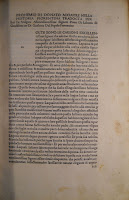 Quick, what is this? An early example of printing or a late-medieval manuscript?
Quick, what is this? An early example of printing or a late-medieval manuscript?The answer is a little complicated. The words were printed in 1476 from movable type by Jacobus Rubeus in Venice, that's just seven years after print was introduced to that city. But the printer did not see his role as usurping the whole of book production. In fact, just like the manuscript scribes, he consciously left space for an illuminator to complete his printed page.
 We are fortunate to have two copies of this particular printing of Leonardo Bruni's Historia Florentina, one printed on vellum and illuminated, the other printed on paper without the finishing work. Note in the image of non-illuminated copy that a small "m" was placed in the opening as a guide letter for the illuminator.
We are fortunate to have two copies of this particular printing of Leonardo Bruni's Historia Florentina, one printed on vellum and illuminated, the other printed on paper without the finishing work. Note in the image of non-illuminated copy that a small "m" was placed in the opening as a guide letter for the illuminator.The two copies point to the gradual transition that took place after the introduction of movable type. Printers created books that fit with the aesthetic and expectations of their market. Illuminated printed books are common in the incunabula period (from 1455 to 1501), but become very rare in the 16th century when printers relied on woodcut initial letters to complete their texts.
To see them, ask for Incunabula 135 and Lansburgh 36.
